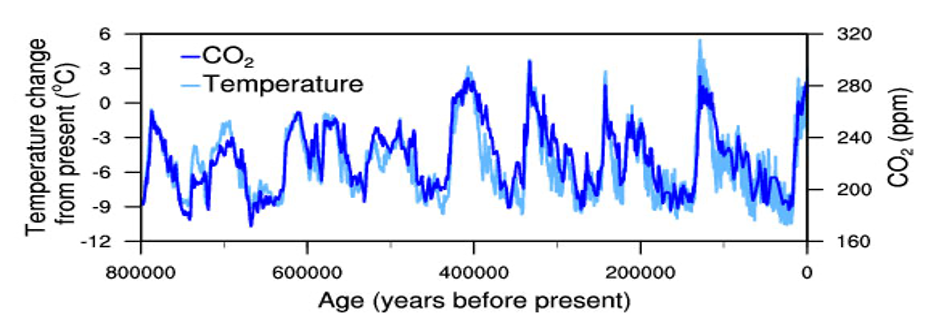We will now examine the impact of anthropogenic emissions of greenhouse gases on the average surface temperature of the Earth.
Part 3: Temperature Impact of Anthropogenic Emissions
Figure 7 shows the paleoclimatic record which was reconstructed from measuring growth layers and air bubbles trapped in Antarctic ice cores dating back 800,000 years. The record shows a strong correspondence between the average surface temperature and atmospheric concentration of carbon dioxide.
The period on record spans less than a million years, so it is not terribly long on the geologic time scale; however, the correspondence illustrates the correlation between the greenhouse effect and the relative abundance or scarcity of its main active component, carbon dioxide.

On smaller timescales, the temperature record is less clear-cut due to the impact of short-term variations in drivers, such as solar and volcanic activity, that average out in the longer-term record.
The scientific consensus on climate change is formulated and summarized by the Physical Science Working Group (WG1) of the UN’s International Panel on Climate Change (IPCC). The 2021 report of the IPCC WG1 is the result of eight years of research and summarizes the results from over 14,000 scientific papers.
The report states unequivocally that the global average temperature increase observed from the mid-20thcentury onward constitutes a significant departure from the patterns in the previous millennia and the average temperatures that would reasonably be expected if there were little or no anthropogenic emissions of greenhouse gases (Figure 8).

Figure 8 - Anthropogenic CO2 Emissions and Average Global Temperature (IPCC AR6 WGI, 2021)
The consequences of long-term temperature increases are manifold, but the most immediate and visible impact is on the water cycle. With higher ambient temperatures, more ice will melt, more free water will evaporate, and more precipitation will fall. Wind and weather patterns will shift and intensify. The sea level will rise as melting land ice runs off into the oceans and because of thermal expansion. Ocean currents will change force and direction.
The main questions with anthropogenic climate change are not if or when it will happen (it is happening right now), but how fast it will happen and what the likely impacts will be.
When a global change is gradual, ecosystems will realign slowly, and life will evolve and adapt to thrive in the new conditions. When change is sudden or drastic, evolution cannot keep up and mass extinction events result. Are we on the verge of triggering a mass extinction event that will wipe out all higher lifeforms living today or are we merely making life very unpleasant for future generations?
Unsurprisingly, there is no lack of strong opinions either way.
